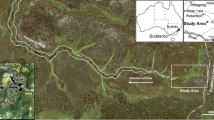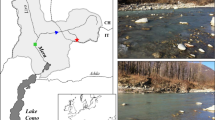Abstract
Understanding environmental factors that influence obligate groundwater dwelling (stygobiotic) fauna is crucial for groundwater ecosystem monitoring and management. Field studies have indicated geological factors are a major influence on the abundance and richness of stygofauna, however the precise mechanisms and true influence of the aquifer sediment matrix on biota is unclear. In this study we examined the habitat use and preferences, in terms of sediment particle sizes, of stygobiotic meiofauna (Harpacticoida and Cyclopoida Copepoda), and macroinvertebrates (Amphipoda and Syncarida) using laboratory microcosms. We first tested the ability of each taxon to use (move into) clay (< 0.06 mm), sand (0.3–0.7 mm) and gravel sediments (2–4 mm). Subsequently, the preference for each sediment was compared by examining the distribution of animals in microcosms containing two different sediment types. Both the harpacticoids and cyclopoids were able to use clay, whereas larger amphipods and syncarids mostly remained on the sediment surface. All taxa were able to use sand and gravel substrates. Amphipods preferred gravel over sand and clay. Both copepods and syncarids preferred sand and gravel over clay, but showed no preference between gravel and sand. This study demonstrates the general inability of some stygobiotic macroinvertebrates to use clay sediments and overall differences in sediment use among stygobiotic meio- and macrofauna. From these findings, the typically heterogenous distributions and diversity of stygofauna observed in field studies may be related to variability in sediment composition.



Similar content being viewed by others
References
Asmyhr MG (2013) Biodiversity assessment and conservation of groundwater ecosystems. PhD Thesis. Macquarie University, Sydney, Australia
Asmyhr MG, Hose G, Graham P, Stow AJ (2014) Fine-scale genetics of subterranean syncarids. Freshwat Biol 59:1–11
Belanger J (2013) Appendage diversity and modes of locomotion: walking. In: Watling L, Theil M (eds) The natural history of crustacea; functional morphology and diversity. Oxford University Press, New York, pp 262–275
Bork J, Berkhoff SE, Bork S, Hahn HJ (2008) Using subsurface metazoan fauna to indicate groundwater–surface water interactions in the Nakdong River floodplain, South Korea. Hydrogeol J 17:61–75
Boulton A, Humphreys W, Eberhard S (2003) Imperilled subsurface waters in Australia: biodiversity, threatening processes and conservation. Aquat Ecosyst Health Manag 6:41–54
Brown A, Trueman E (1996) Burrowing behaviour and cost in the sandy-beach oniscid isopod Tylos granulatus Krauss, 1843. Crustaceana 69:425–437
Che J, Dorgan KM (2010) It’s tough to be small: dependence of burrowing kinematics on body size. J Exp Biol 213:1241–1250
Datry T, Malard F, Gibert J (2005) Response of invertebrate assemblages to increased groundwater recharge rates in a phreatic aquifer. J Nth Am Benthol Soc 24:461–477
Descloux S, Datry T, Marmonier P (2013) Benthic and hyporheic invertebrate assemblages along a gradient of increasing streambed colmation by fine sediment. Aquat Sci 75:493–507. https://doi.org/10.1007/s00027-013-0295-6
Descloux S, Datry T, Usseglio-Polatera P (2014) Trait-based structure of invertebrates along a gradient of sediment colmation: benthos versus hyporheos responses. Sci Total Environ 466–467:265–276
Di Marzio W, Castaldo D, Pantani C, Di Cioccio A, Di Lorenzo T, Sáenz M, Galassi D (2009) Relative sensitivity of hyporheic copepods to chemicals. Bull Environ Contam Toxicol 82:488–491
Dole-Olivier MJ, Galassi D, Marmonier P, Creuzé Des Châtelliers M (2000) The biology and ecology of lotic microcrustaceans. Freshwat Biol 44:63–91
Dorgan KM (2015) The biomechanics of burrowing and boring. J Exp Biol 218:176–183
Dorgan KM, Jumars PA, Johnson B, Boudreau B, Landis E (2005) Burrowing mechanics: burrow extension by crack propagation. Nature 433:475
Dorgan K, Jumars PA, Johnson B, Boudreau B (2006) Macrofaunal burrowing: the medium is the message. Oceanogr Mar Biol Ann Rev 48:85–121
Extence CA (1981) The effect of drought on benthic invertebrate communities in a lowland river. Hydrobiologia 83:217–224
Fattorini S, Borges PAV, Fiasca B, Galassi DMP (2016) Trapped in the web of water: groundwater-fed springs are island-like ecosystems for the meiofauna. Ecol Evol 6:8389–8401
Faulkes Z (2013) Morphological adaptations for digging and burrowing. In: Watling L, Theil M (eds) The natural history of crustacea; functional morphology and diversity. Oxford University Press, New York, pp 276–284
Fetter CW (2001) Applied hydrogeology. Prentice Hall, Upper Saddle River
Fiasca B, Stoch F, Olivier MJ, Maazouzi C, Petitta M, Di Cioccio A, Galassi DMP (2014) The dark side of springs: what drives small-scale spatial patterns of subsurface meiofaunal assemblages? J Limnol 73:71–80
Galassi DM, Huys R, Reid JW (2009) Diversity, ecology and evolution of groundwater copepods. Freshwat Biol 54:691–708
Gibert J, Deharveng L (2002) Subterranean ecosystems: a truncated functional biodiversity. Bioscience 52:473–481
Glanville K, Schulz C, Tomlinson M, Butler D (2016) Biodiversity and biogeography of groundwater invertebrates in Queensland, Australia. Subterr Biol 17:55–76
Hahn HJ (2005) Unbaited phreatic traps: a new method of sampling stygofauna. Limnologica 35:248–261
Hahn HJ (2006) The GW-Fauna-Index: a first approach to a quantitative ecological assessment of groundwater habitats. Limnologica 36:119–137
Hahn HJ, Matzke D (2005) A comparison of stygofauna communities inside and outside groundwater bores. Limnologica 35:31–44
Hancock PJ, Boulton AJ (2008) Stygofauna biodiversity and endemism in four alluvial aquifers in eastern Australia. Invert Syst 22:117–126
Hervant F, Mathieu J, Barre H, Simon K, Pinon C (1997) Comparative study on the behavioral, ventilatory, and respiratory responses of hypogean and epigean crustaceans to long-term starvation and subsequent feeding. Comp Biochem Physiol A Physiol 118:1277–1283
Hervant F, Mathieu J, Messana G (1998) Oxygen consumption and ventilation in declining oxygen tension and posthypoxic recovery in epigean and hypogean crustaceans. J Crustac Biol 18:717–727
Hose GC, Stumpp C (2019) Architects of the underworld: bioturbation by groundwater invertebrates influences aquifer hydraulic properties. Aquat Sci 81:20
Hose GC, Jones P, Lim RP (2005) Hyporheic macroinvertebrates in riffle and pool areas of temporary streams in south-eastern Australia. Hydrobiologia 532:81–90
Hose GC, Asmyhr MG, Cooper SJB, Humphreys WF (2015a) Down under down under: austral groundwater life. In: Stow A, Maclean N, Holwell GI (eds) Austral ark. Cambridge University Press, Cambridge, pp 512–536
Hose GC, Sreekanth J, Barron O, Pollino C (2015) Stygofauna in Australian Groundwater Systems: Extent of knowledge. In: Report to Australian Coal Association Research Program. Macquarie University and CSIRO
Hose GC, Symington K, Lott MJ, Lategan MJ (2016) The toxicity of arsenic (III), chromium (VI) and zinc to groundwater copepods. Environ Sci Pollut Res 23:18704–18713
Hose GC, Fryirs KA, Bailey J, Ashby N, White T, Stumpp C (2017) Different depths, different fauna: habitat influences on the distribution of groundwater invertebrates. Hydrobiologia 797:145–157
Humphreys WF (2006) Aquifers: the ultimate groundwater-dependent ecosystems. Aust J Bot 54:115–132
Johns T, Jones JI, Knight L, Maurice L, Wood P, Robertson A (2015) Regional-scale drivers of groundwater faunal distributions. Freshwat Sci 34:316–328
Korbel KL, Hose GC (2015) Habitat, water quality, seasonality, or site? Identifying environmental correlates of the distribution of groundwater biota. Freshwat Sci 34:329–343
Korbel KL, Hose GC (2017) The weighted groundwater health index: improving the monitoring and management of groundwater resources. Ecol Ind 75:164–181
Korbel KL, Hancock PJ, Serov P, Lim RP, Hose GC (2013a) Groundwater ecosystems vary with land use across a mixed agricultural landscape. J Environ Qual 42:380–390
Korbel KL, Lim RP, Hose GC (2013b) An inter-catchment comparison of groundwater biota in the cotton-growing region of north-western New South Wales. Crop Pasture Sci 64:1195–1208
Korbel K, Chariton A, Stephenson S, Greenfield P, Hose GC (2017) Wells provide a distorted view of life in the aquifer: implications for sampling, monitoring and assessment of groundwater ecosystems. Sci Rep 7:40702
Mathers KL, Millett J, Robertson AL, Stubbington R, Wood PJ (2014) Faunal response to benthic and hyporheic sedimentation varies with direction of vertical hydrological exchange. Freshwat Biol 59:2278–2289
Mathers KL, Hill MJ, Wood PJ (2017) Benthic and hyporheic macroinvertebrate distribution within the heads and tails of riffles during baseflow conditions. Hydrobiologia 794:17–30
Mermillod-Blondin F, Winiarski T, Foulquier A, Perrissin A, Marmonier P (2015) Links between sediment structures and ecological processes in the hyporheic zone: ground-penetrating radar as a non-invasive tool to detect subsurface biologically active zones. Ecohydrology 8:626–641
Rau GC, Halloran LJ, Cuthber MO, Andersen MS, Acworth RI, Tellam JH (2017) Characterising the dynamics of surface water–groundwater interactions in intermittent and ephemeral streams using streambed thermal signatures. Adv Water Res 107:354–369
Schmidt SI, Hellweg J, Hahn HJ, Hatton TJ, Humphreys WF (2007) Does groundwater influence the sediment fauna beneath a small, sandy stream? Limnologica 37:208–225
Sket B (2008) Can we agree on an ecological classification of subterranean animals? J Nat Hist 42:1549–1566
Sorensen JPR, Maurice L, Edwards FK, Lapworth DJ, Read DS, Allen D, Butcher AS, Newbold LK, Townsend BR, Williams PJ (2013) Using boreholes as windows into groundwater ecosystems. PLoS One 8:e70264
Stakman W (1966) The relation between particle size, pore size and hydraulic conductivity of sand separates. In: Proceedings of the Wageningen Symposium. Water in the unsaturated zone. International Association of Scientific Hydrology, The Netherlands, pp 373–384
Stanford JA, Ward J (1993) An ecosystem perspective of alluvial rivers: connectivity and the hyporheic corridor. J N Am Benthol Soc 12:48–60
Stoch F, Artheau M, Brancelj A, Galassi DM, Malard F (2009) Biodiversity indicators in European ground waters: towards a predictive model of stygobiotic species richness. Freshwat Biol 4:745–755
Stubbington R, Greenwood AM, Wood PJ, Armitage PD, Gunn J, Robertson AL (2009) The response of perennial and temporary headwater stream invertebrate communities to hydrological extremes. Hydrobiologia 630:299–312
Stubbington R, Wood PJ, Reid I, Gunn J (2011) Benthic and hyporheic invertebrate community responses to seasonal flow recession in a groundwater-dominated stream. Ecohydrology 4:500–511
Stubbington R, Boulton AJ, Little S, Wood PJ (2015) Changes in invertebrate assemblage composition in benthic and hyporheic zones during a severe supraseasonal drought. Freshwat Sci 34:344–354
Stumpp C, Hose GC (2013) The impact of water table drawdown and drying on subterranean aquatic fauna in in vitro experiments. PLoS One 8:e78502
Stumpp C, Hose GC (2017) Groundwater amphipods alter aquifer sediment structure. Hydrolog Proc 31:3452–3454
Tomlinson M (2008) A framework for determining environmental water requirements for alluvial aquifer ecosystems. PhD Thesis. University of New England, Armidale, Australia
Vadher AN, Stubbington R, Wood PJ (2015) Fine sediment reduces vertical migrations of Gammarus pulex (Crustacea: Amphipoda) in response to surface water loss. Hydrobiologia 753:61–71
Vadher AN, Leigh C, Millett J, Stubbington R, Wood PJ (2017) Vertical movements through subsurface stream sediments by benthic macroinvertebrates during experimental drying are influenced by sediment characteristics and species traits. Freshwat Biol 62:1730–1740
Vander Vorste R, Malard F, Datry T (2016) Is drift the primary process promoting the resilience of river invertebrate communities? A manipulative field experiment in an intermittent alluvial river. Freshwat Biol 61:1276–1292
Viola SM, Hubbard DM, Dugan JE, Schooler NK (2014) Burrowing inhibition by fine textured beach fill: implications for recovery of beach ecosystems. Estuar Coast Shelf Sci 150:142–148
Wentworth CK (1922) A scale of grade and class terms for clastic sediments. J Geol 30:377–392
White T (2018) The effect of drawdown on the movement of groundwater invertebrates. In: Unpublished Maters thesis. Macquarie University, Australia
Wood P, Armitage PD (1997) Biological effects of fine sediment in the lotic environment. Environ Manag 21:203–217
Acknowledgements
This work was funded by the Cotton Research and Development Corporation project MQ1501 and Australian Research Council project LP130100508. We are grateful for the thoughtful and constructive comments provided by three anonymous reviewers.
Author information
Authors and Affiliations
Corresponding author
Additional information
Publisher's Note
Springer Nature remains neutral with regard to jurisdictional claims in published maps and institutional affiliations.
Electronic supplementary material
Below is the link to the electronic supplementary material.
Rights and permissions
About this article
Cite this article
Korbel, K.L., Stephenson, S. & Hose, G.C. Sediment size influences habitat selection and use by groundwater macrofauna and meiofauna. Aquat Sci 81, 39 (2019). https://doi.org/10.1007/s00027-019-0636-1
Received:
Accepted:
Published:
DOI: https://doi.org/10.1007/s00027-019-0636-1




